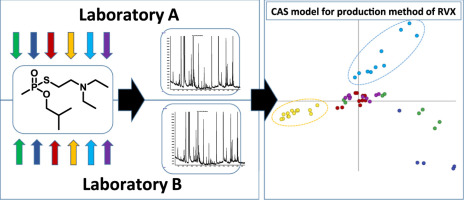Talanta ( IF 6.1 ) Pub Date : 2018-03-08 , DOI: 10.1016/j.talanta.2018.02.104 Karin Höjer Holmgren , Carlos A. Valdez , Roger Magnusson , Alexander K. Vu , Sandra Lindberg , Audrey M. Williams , Armando Alcaraz , Crister Åstot , Saphon Hok , Rikard Norlin

|
Chemical attribution signatures (CAS) associated with different synthetic routes used for the production of Russian VX (VR) were identified. The goal of the study was to retrospectively determine the production method employed for an unknown VR sample. Six different production methods were evaluated, carefully chosen to include established synthetic routes used in the past for large scale production of the agent, routes involving general phosphorus-sulfur chemistry pathways leading to the agent, and routes whose main characteristic is their innate simplicity in execution. Two laboratories worked in parallel and synthesized a total of 37 batches of VR via the six synthetic routes following predefined synthesis protocols. The chemical composition of impurities and byproducts in each route was analyzed by GC/MS-EI and 49 potential CAS were recognized as important markers in distinguishing these routes using Principal Component Analysis (PCA). The 49 potential CAS included expected species based on knowledge of reaction conditions and pathways but also several novel compounds that were fully identified and characterized by a combined analysis that included MS-CI, MS-EI and HR-MS. The CAS profiles of the calibration set were then analyzed using partial least squares discriminant analysis (PLS-DA) and a cross validated model was constructed. The model allowed the correct classification of an external test set without any misclassifications, demonstrating the utility of this methodology for attributing VR samples to a particular production method. This work is part one of a three-part series in this Forensic VSI issue of a Sweden-United States collaborative effort towards the understanding of the CAS of VR in diverse batches and matrices. This part focuses on the CAS in synthesized batches of crude VR and in the following two parts of the series the influence of food matrices on the CAS profiles are investigated.
中文翻译:

第1部分:通过化学归因签名的多元统计数据追踪俄罗斯VX的合成路线
确定了与用于生产俄罗斯VX(VR)的不同合成路线相关的化学归因标记(CAS)。该研究的目的是回顾性确定未知VR样品的生产方法。对六种不同的生产方法进行了评估,经过仔细选择,以包括过去用于大规模生产试剂的既定合成路线,涉及导致该试剂的一般磷硫化学途径的路线以及主要特征在于其固有的执行简便性的路线。两个实验室并行工作,并按照预定义的合成方案,通过六种合成途径合成了总共37批VR。通过GC / MS-EI分析了每种途径中的杂质和副产物的化学组成,使用主成分分析(PCA)将49种潜在的CAS视为区分这些途径的重要标志。49种潜在的CAS包括基于反应条件和途径知识的预期物种,而且还包括通过MS-CI,MS-EI和HR-MS组合分析得到充分鉴定和表征的几种新型化合物。然后使用偏最小二乘判别分析(PLS-DA)分析校准集的CAS轮廓,并构建交叉验证的模型。该模型可以对外部测试集进行正确分类,而不会发生任何错误分类,这证明了该方法可将VR样本归因于特定的生产方法。这项工作是本期法医VSI问题的三部分系列之一,这是瑞典-美国合作努力的成果,旨在了解不同批次和基质的VR的CAS。本部分重点介绍了合成VR批次中的CAS,在该系列的以下两个部分中,研究了食品基质对CAS曲线的影响。


























 京公网安备 11010802027423号
京公网安备 11010802027423号